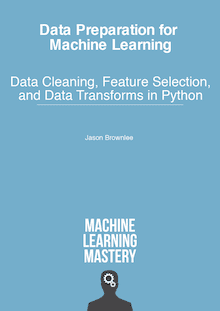Should You Always Do Dimensionality Reduction In Machine Learning
Introduction to Dimensionality Reduction for Machine Learning
Last Updated on June 30, 2020
The number of input variables or features for a dataset is referred to every bit its dimensionality.
Dimensionality reduction refers to techniques that reduce the number of input variables in a dataset.
More than input features ofttimes make a predictive modeling chore more challenging to model, more than generally referred to equally the curse of dimensionality.
High-dimensionality statistics and dimensionality reduction techniques are often used for information visualization. Notwithstanding these techniques tin exist used in applied machine learning to simplify a nomenclature or regression dataset in order to meliorate fit a predictive model.
In this post, yous will discover a gentle introduction to dimensionality reduction for auto learning
After reading this post, you will know:
- Large numbers of input features can cause poor functioning for machine learning algorithms.
- Dimensionality reduction is a full general field of study concerned with reducing the number of input features.
- Dimensionality reduction methods include feature selection, linear algebra methods, project methods, and autoencoders.
Kick-offset your project with my new book Data Preparation for Machine Learning, including footstep-by-step tutorials and the Python source code files for all examples.
Allow's become started.
- Updated May/2020: Inverse section headings to be more than accurate.

A Gentle Introduction to Dimensionality Reduction for Auto Learning
Photo by Kevin Jarrett, some rights reserved.
Overview
This tutorial is divided into three parts; they are:
- Problem With Many Input Variables
- Dimensionality Reduction
- Techniques for Dimensionality Reduction
- Feature Selection Methods
- Matrix Factorization
- Manifold Learning
- Autoencoder Methods
- Tips for Dimensionality Reduction
Trouble With Many Input Variables
The performance of machine learning algorithms can dethrone with too many input variables.
If your data is represented using rows and columns, such as in a spreadsheet, and so the input variables are the columns that are fed as input to a model to predict the target variable. Input variables are also called features.
Nosotros tin consider the columns of information representing dimensions on an n-dimensional characteristic space and the rows of data as points in that space. This is a useful geometric interpretation of a dataset.
Having a big number of dimensions in the feature space tin can hateful that the book of that space is very large, and in turn, the points that we have in that space (rows of data) often represent a small and non-representative sample.
This can dramatically bear on the operation of machine learning algorithms fit on data with many input features, generally referred to as the "curse of dimensionality."
Therefore, it is ofttimes desirable to reduce the number of input features.
This reduces the number of dimensions of the feature space, hence the name "dimensionality reduction."
Desire to Get Started With Data Grooming?
Accept my free 7-day email crash course now (with sample code).
Click to sign-up and also get a complimentary PDF Ebook version of the class.
Dimensionality Reduction
Dimensionality reduction refers to techniques for reducing the number of input variables in preparation information.
When dealing with high dimensional data, it is frequently useful to reduce the dimensionality past projecting the information to a lower dimensional subspace which captures the "essence" of the data. This is called dimensionality reduction.
— Page 11, Auto Learning: A Probabilistic Perspective, 2012.
High-dimensionality might mean hundreds, thousands, or even millions of input variables.
Fewer input dimensions often hateful correspondingly fewer parameters or a simpler structure in the automobile learning model, referred to every bit degrees of liberty. A model with too many degrees of freedom is likely to overfit the training dataset and therefore may not perform well on new data.
It is desirable to take uncomplicated models that generalize well, and in turn, input data with few input variables. This is peculiarly true for linear models where the number of inputs and the degrees of freedom of the model are oftentimes closely related.
The fundamental reason for the curse of dimensionality is that high-dimensional functions take the potential to be much more than complicated than low-dimensional ones, and that those complications are harder to discern. The only way to beat out the curse is to incorporate cognition about the data that is correct.
— Page 15, Design Classification, 2000.
Dimensionality reduction is a data preparation technique performed on data prior to modeling. It might be performed after data cleaning and data scaling and before training a predictive model.
… dimensionality reduction yields a more meaty, more than easily interpretable representation of the target concept, focusing the user's attending on the most relevant variables.
— Page 289, Data Mining: Practical Machine Learning Tools and Techniques, 4th edition, 2016.
As such, any dimensionality reduction performed on preparation data must also be performed on new data, such as a exam dataset, validation dataset, and information when making a prediction with the last model.
Techniques for Dimensionality Reduction
There are many techniques that can be used for dimensionality reduction.
In this section, nosotros will review the main techniques.
Feature Selection Methods
Perhaps the near common are then-chosen feature selection techniques that utilise scoring or statistical methods to select which features to keep and which features to delete.
… perform feature selection, to remove "irrelevant" features that do not help much with the nomenclature problem.
— Page 86, Machine Learning: A Probabilistic Perspective, 2012.
2 chief classes of feature selection techniques include wrapper methods and filter methods.
For more on feature selection in general, see the tutorial:
- An Introduction to Feature Option
Wrapper methods, as the name suggests, wrap a auto learning model, fitting and evaluating the model with dissimilar subsets of input features and selecting the subset the results in the all-time model performance. RFE is an example of a wrapper feature selection method.
Filter methods use scoring methods, like correlation between the characteristic and the target variable, to select a subset of input features that are nigh predictive. Examples include Pearson's correlation and Chi-Squared examination.
For more on filter-based feature choice methods, see the tutorial:
- How to Cull a Characteristic Selection Method for Machine Learning
Matrix Factorization
Techniques from linear algebra tin be used for dimensionality reduction.
Specifically, matrix factorization methods can be used to reduce a dataset matrix into its constituent parts.
Examples include the eigendecomposition and singular value decomposition.
For more on matrix factorization, encounter the tutorial:
- A Gentle Introduction to Matrix Factorization for Machine Learning
The parts tin can then be ranked and a subset of those parts tin can be selected that best captures the salient construction of the matrix that can be used to correspond the dataset.
The most common method for ranking the components is principal components assay, or PCA for curt.
The most common approach to dimensionality reduction is chosen main components assay or PCA.
— Page 11, Car Learning: A Probabilistic Perspective, 2012.
For more than on PCA, see the tutorial:
- How to Calculate Primary Component Analysis (PCA) From Scratch in Python
Manifold Learning
Techniques from high-dimensionality statistics can also be used for dimensionality reduction.
In mathematics, a projection is a kind of function or mapping that transforms information in some way.
— Page 304, Information Mining: Practical Machine Learning Tools and Techniques, 4th edition, 2016.
These techniques are sometimes referred to as "manifold learning" and are used to create a low-dimensional projection of loftier-dimensional data, frequently for the purposes of data visualization.
The projection is designed to both create a low-dimensional representation of the dataset whilst all-time preserving the salient structure or relationships in the data.
Examples of manifold learning techniques include:
- Kohonen Self-Organizing Map (SOM).
- Sammons Mapping
- Multidimensional Scaling (MDS)
- t-distributed Stochastic Neighbor Embedding (t-SNE).
The features in the projection often have piffling human relationship with the original columns, e.g. they do non have column names, which can be disruptive to beginners.
Autoencoder Methods
Deep learning neural networks can exist constructed to perform dimensionality reduction.
A popular approach is called autoencoders. This involves framing a self-supervised learning problem where a model must reproduce the input correctly.
For more on cocky-supervised learning, come across the tutorial:
- 14 Different Types of Learning in Motorcar Learning
A network model is used that seeks to compress the data catamenia to a bottleneck layer with far fewer dimensions than the original input data. The part of the model prior to and including the bottleneck is referred to equally the encoder, and the role of the model that reads the bottleneck output and reconstructs the input is called the decoder.
An car-encoder is a kind of unsupervised neural network that is used for dimensionality reduction and characteristic discovery. More precisely, an auto-encoder is a feedforward neural network that is trained to predict the input itself.
— Page 1000, Machine Learning: A Probabilistic Perspective, 2012.
After training, the decoder is discarded and the output from the bottleneck is used directly equally the reduced dimensionality of the input. Inputs transformed by this encoder can and so be fed into another model, not necessarily a neural network model.
Deep autoencoders are an effective framework for nonlinear dimensionality reduction. Once such a network has been built, the height-virtually layer of the encoder, the code layer hc, can be input to a supervised classification procedure.
— Page 448, Information Mining: Practical Automobile Learning Tools and Techniques, quaternary edition, 2016.
The output of the encoder is a type of project, and like other projection methods, there is no direct relationship to the bottleneck output back to the original input variables, making them challenging to translate.
For an instance of an autoencoder, run into the tutorial:
- A Gentle Introduction to LSTM Autoencoders
Tips for Dimensionality Reduction
At that place is no all-time technique for dimensionality reduction and no mapping of techniques to bug.
Instead, the all-time approach is to use systematic controlled experiments to observe what dimensionality reduction techniques, when paired with your model of choice, result in the best performance on your dataset.
Typically, linear algebra and manifold learning methods assume that all input features have the same scale or distribution. This suggests that it is adept practice to either normalize or standardize data prior to using these methods if the input variables have differing scales or units.
Further Reading
This section provides more resources on the topic if you are looking to go deeper.
Tutorials
- An Introduction to Feature Pick
- How to Choose a Feature Selection Method For Automobile Learning
- A Gentle Introduction to Matrix Factorization for Machine Learning
- How to Calculate Principal Component Analysis (PCA) from Scratch in Python
- 14 Different Types of Learning in Machine Learning
- A Gentle Introduction to LSTM Autoencoders
Books
- Auto Learning: A Probabilistic Perspective, 2012.
- Data Mining: Practical Machine Learning Tools and Techniques, fourth edition, 2016.
- Pattern Nomenclature, 2000.
API
- Manifold learning, scikit-larn.
- Decomposing signals in components (matrix factorization problems), scikit-acquire.
Manufactures
- Dimensionality reduction, Wikipedia.
- Curse of dimensionality, Wikipedia.
Summary
In this post, you discovered a gentle introduction to dimensionality reduction for machine learning.
Specifically, you learned:
- Big numbers of input features can cause poor performance for automobile learning algorithms.
- Dimensionality reduction is a general field of report concerned with reducing the number of input features.
- Dimensionality reduction methods include characteristic selection, linear algebra methods, projection methods, and autoencoders.
Do you have any questions?
Ask your questions in the comments beneath and I will do my all-time to answer.
Should You Always Do Dimensionality Reduction In Machine Learning,
Source: https://machinelearningmastery.com/dimensionality-reduction-for-machine-learning/
Posted by: sandbergmudis1966.blogspot.com



0 Response to "Should You Always Do Dimensionality Reduction In Machine Learning"
Post a Comment